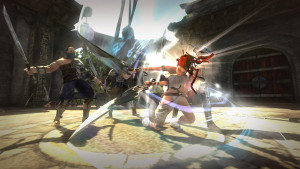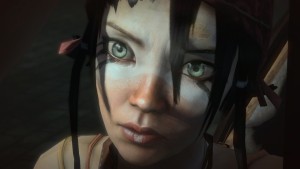After recovering from a trip to the Chicago office for a technical design summit, I finally managed to crack open Super Mario Galaxy and give it a whirl. Considering it is apparently proving out to be the greatest game of all time, my expectations were high.
I was an incredibly huge fan of Super Mario 64, which I put up as my favorite game of all time. That game was a pioneer in so many ways, and its gameplay still holds up quite well today. It had an extremely workable camera that was tuned for each area you went through, and along with its controls, they went unmatched for many years after its release. (Maybe Prince of Persia: Sands of Time, another favorite of mine, finally matched it?)
Of course I was waiting for this game because I would love another Mario 64. Unfortunately I went through this same anticipation five years ago for Super Mario Sunshine and was gravely disappointed. I ask around a lot about what was wrong with Sunshine and I get very vague answers. It had all the trappings of Mario 64, but why did it fall flat? Thinking back I think it was an uncompelling package, another “island paradise” with arbitrary block puzzles sprinkled in. More offensive was that damn backpack/watergun thing. Mario is about motion, and that “clean up the gunk” spray nozzle thing required me to keep Mario in place. What were they thinking?!? Seeing that nobody that I know liked it (and even reviewers retroactively dis that game), but it still netted a 92% on GameRankings, I certainly have to take all the hype for Galaxy with a grain of salt.

So Sunday I cracked Galaxy open and was drawn in. In a couple of good sessions I went through two full galaxies and probably about 25 stars. I’m a completionist so I went for all the secondary objectives first before moving to the next area.
Here are a pile of impressions:
- The Wii control scheme, for maybe the first time in my experience, isn’t annoying at all. You move Mario with the stick like you always did, but somehow the disconnected nunchuck feels better than a gamepad stick might, because it isn’t a big slab and can be tilted to help orient you to the action.
- Thank fucking god they ditched the “flip the wiimote to jump” thing that they toyed with a couple years ago. You just press the A button as you’d expect, which doesn’t give you the 1/4 second delay you get with gestural motion in most Wii games. That would have killed Mario.
- This is hopefully a very good sign for Wii. It seems like when it was introduced, everyone out there was trying to use fancy whirls and flips to do mundane things. Tilt the wiimote to steer? Wow, dude, you just invented the joystick. Shake the wiimote to make Link attack? You just invented the button, asshole.
- Some of the wiimote point-at-this mechanics are a bit weird, such as the float-stars that pull Mario along, but they do feel pretty unique and perhaps not easily replaceable with a button (there are advanced techniques like gravity slinging that start to emerge later).
- The sticky slingshot-thing (where you pull back with the wiimote to fling Mario at a target) certainly could have been controlled with a joystick, but in the end it felt like a fairly versatile game tool.
- The secondary use of the wiimote works pretty well. Picking up crystals by pointing the cursor at them is a nice diversion when you’re being launched this way and that, and the idea that a friend can hang out and play crystal control is pretty cool. They do have the “shake to spin” thing that gives a bit of my above gripe, but it feels fairly responsive and doesn’t get too annoying.
- Gravity takes you wherever it wants to. Walking upside-down, leftside-right, frontside-back is disorienting, but somehow he controls and camera manage to bring it home and you quickly adapt. As a result, you get a weird sort of topsy-turvy feeling that somehow you continue to keep control. It’s exhilarating, and addicting.
- The camera can be a bit disorienting, such as when you are in an upside-down overhead view, trying to head stomp something. Only a couple times was I at a loss for control, such as when Mario is walking on some glass spheres and the camera doesn’t move when he’s on the other side, leaving you staring at Mario’s feet through distorted glass, wondering which way was up. The moment was so magical, however, that I hardly minded.
- The incredible Psychonauts was the only other game that I can think of that did this well (such as the Milkman level, which for me was the moment the game went from curious to sublime).
- The puzzles use their main mechanics in very interesting ways. Gravity will flip you this way and that, and it’s also localized, so you’ll meet challenges where you leap up into a zone that snares you with reverse gravity so you land on the ceiling. They could have stumped players, but the mechanics are so well communicated that you just feel totally in control.
- The “collect crystals” mechanic is pretty weird though. First of all, you can “shoot” them, but so far that mechanic hasn’t been very important… You can use it to stun enemies if you don’t want to risk spin-attacking them or hopping on their heads, but I’m not sure that giving Mario a weak “gun” really added to the game. So far it’s been a redundant mechanic other than a couple times that it was shoehorned in as a required action.

- Oddly, the crystals you collectare the same ones you use as ammunition when you shoot. I’m not generally a fan of combining two very opposing purposes into single resources (imagine a shooter where your health was your ammo) because you become gun-shy (no pun intended) about using it. I really avoid shooting crystals very much, but so far the “currency” I’ve expended to unlock stars/doors has been pretty minimal, so maybe I’ll loosen up. I’m just worried that I’ll get halfway through the game and some mushroom-headed star mutant will ask me for 5000 in order to get some super-awesome thing.
- Also, the “aim to collect crystals” is a bit weird since no other pickups like coins and so on work that way. I’m glad that I can hoover up dozens of the little things in seconds, or even grab them while in flight, but it can be a bit of a mental switch when you scoop up all those crystals and then have to walk over to grab the one coin. Of course it makes sense, because coins regain health, and I’m getting used to it.
- Moving Mario is easy, as it always is (damn those guys can just nail motion). All the Mario 64 moves exist, but some are easier like the wall-jump (Mario “sticks” to a vertical surface for a quarter second before sliding down, giving you a chance to launch again).
- The moves, however, are more or less undermined by the spin attack, however, which you can use during a jump to go higher and further. This pretty much negates the need for the old standbys of the triple-jump, crouch-backflip and the crouch-longjump. In a sense it feels like those old moves are just there as a nod to the previous game, although it felt nice and comfortable to know they were there.
- Sending Mario into space is strange but oddly refreshing. After how stale the “island paradise” felt in Sunshine (what, am I suddenly playing Sonic Adventure again?), this suddenly felt like a wild reinvention of classic Mario themes.
- However, I did lack a sense of place in some cases. I came to “know” these little chunks of rock, but the early part of the game really felt like I was being led by the nose, getting to a launch star and being sent to another planet over and over again. There wasn’t a sense of “planning” to it, nor did I feel in control of my exploration. But, nobody ever accused Mario of being open-world, so the fact that these paths are mostly linear seems appropriate to the series history.
- The sight range was incredibly long, and it was amazing to be able to see these little chunks of rock far in the distance. I could even wave my wiimote pointer at them and steal distant crystals from the surface. My only regret was that I didn’t feel like an explorer… I wanted to see that piece of rock in the distance and figure out how to get to it. Instead I just went where the game led me next.

- They still have lives. You pick up the mushrooms to get an extra life, and gaining them is easy. Just like in Mario 64, saving and restoring the game will strip you of all but 5, even if you had 60 of them during a play session. People might consider that mechanic a relic, but it seems very Mario to me.
- Mario still has some of the greatest personality of any game character in existence. Sure, he’s disgustingly cute as he yips and cheers while jumping around, but god damn is he charming. It never gets old to me.
The best moment so far was Megaleg, where you get thrown onto a little planet with this giant robot with big legs towering over you. Once a leg comes down, you climb up the side of it and onto the main body where you finsih him off. It felt like a unique Shadow of the Colossus moment, but even cooler because of the ridiculous exaggeration of the huge robot on a tiny planet.
So overall, I’m really digging Galaxy. Not sure if it is in “greatest game of all time” territory yet, but it’s probably the best game I’ve played this year so far. It adds a completely new angle to platformers in the way that Portal turned the shooter formula on its ear. If anything, it makes me glad to know that new ideas do still exist, waiting out there for us to find them…


